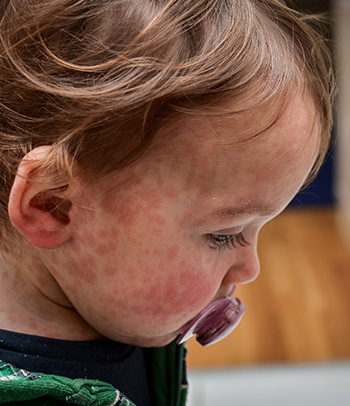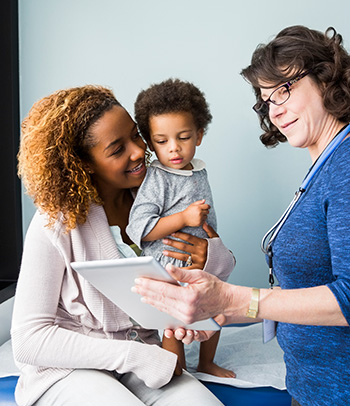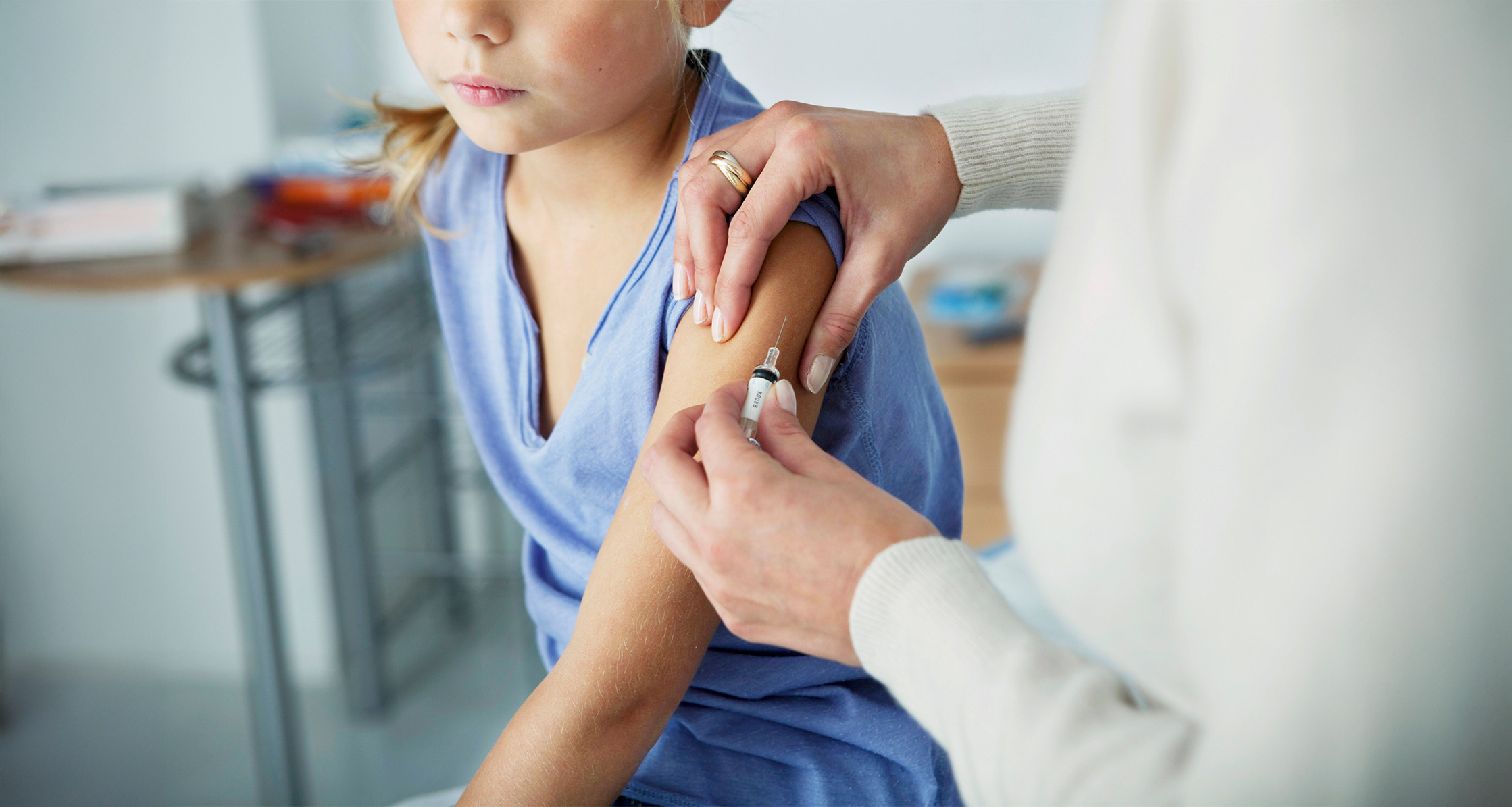Measles is back in the news, and it’s important to understand how to protect yourself and your family from this contagious illness.
Measles is back in the news, and it’s important to understand how to protect yourself and your family from this contagious illness. While outbreaks are generally connected to specific areas, measles cases are rising across the country and have been reported in 41 states.
Anyone who isn’t protected against measles can get the illness, and certain groups, such as young children, are especially at risk of getting seriously sick.
Learn more about measles, what symptoms to look out for, and the best ways to keep you and your family safe.
What Is Measles?
Measles is an extremely contagious airborne illness caused by a virus. Measles can cause a widespread rash and flu-like symptoms, but it can also lead to serious life-threatening complications. Before the vaccine, several hundred people died from measles in the United States each year. An estimated 107,500 people died from measles in 2023 worldwide – mostly children under the age of five years, despite the availability of a safe and cost-effective vaccine.
How Does Measles Spread?
Measles is highly contagious and spreads through the air when an infected person coughs or sneezes. The droplets can remain suspended in the air in a room for up to two hours after the person is gone and the droplets can also land on surfaces. If you touch a surface or object that contains the virus, then touch your mouth, nose or eyes, you can become infected.
Experts estimate that if one person in a room has measles, nine out of 10 people in the room will catch it as well if they are unvaccinated, have not had the disease before, or have a problem with their immune system.
Another reason measles can spread so rapidly is because people with measles are contagious before they know they are sick. An infected person can spread measles to others four days before the rash appears, and they are still contagious four days after the rash appears.
What Are the Symptoms of Measles?
Measles symptoms usually appear 7 to 14 days after infection and can include:
- High fever
- Cough
- Runny nose
- Red, watery eyes
- Tiny white spots in your mouth (2 to 3 days after the start of symptoms)
- A measles rash (3 to 5 days after symptoms start) of flat red spots that usually start on the face at the hairline and spread down the body toward the feet. The spots may become joined together as they spread, and small raised bumps may appear on top of the spots.
Complications from the measles can be mild or life threatening and can include:
- Blindness
- Ear infections
- Diarrhea and dehydration
- Swelling of the brain (encephalitis), which can lead to convulsions and cause deafness or intellectual disability
- Pneumonia (the most common cause of death from measles in young children)
- Death
About one in five unvaccinated people who get measles in the United States end up hospitalized and between one and three of every 1,000 children who become infected will die from complications.
Who Is Most At Risk?
Anyone can get the measles, but complications can be more severe for the following groups:
- Children younger than 5 years of age
- Adults older than 30 years of age
- Pregnant women
- People with weakened immune systems
- People who live in communities with low vaccination rates or who are unvaccinated
Why Is Measles Coming Back?
In 2000, measles was declared eliminated in the United States because such a high percentage of people were receiving the MMR vaccine. Cases only occurred when someone contracted measles abroad and then came back to the United States.
However, in recent years, the number of people vaccinated against measles is dropping. Coverage among kindergarteners is now below the 95 percent coverage target and is decreasing. When 95 percent of people in a community are vaccinated, most people are protected through what is called “community immunity.” However, because vaccination coverage is decreasing, we’re losing community immunity, and outbreaks are on the rise.
How Can I Protect Myself and My Family?
- Get vaccinated. Vaccination is your best defense against measles. Within each outbreak, 95 percent of those affected are unvaccinated or their vaccination status is unknown. Two doses of the measles, mumps and rubella (MMR) vaccine are 97 percent effective at preventing measles. It’s very uncommon for someone who is fully vaccinated to develop measles; however, breakthrough infections can occur, especially in communities where outbreak levels are very high.
- Who should get vaccinated?
- Anyone born before 1957 is generally considered immune to measles. This means they are fully protected from measles for life and no additional vaccination is necessary.
- The CDC also considers people who received two childhood doses of measles vaccine protected for life. If you’re unsure whether you’re immune to measles, you should first try to find your vaccination records or documentation of measles immunity. If you do not have a record of measles immunity, you should get the MMR vaccine. There is no harm in getting another dose of MMR vaccine if you may already be immune to measles (or mumps or rubella).
- For children, the recommended age for the first dose of MMR vaccine is 12 to 15 months of age and the second dose is given between 4 and 6 years of age.
- If you live in or plan to travel to a community experiencing an outbreak, or if you travel internationally, your baby may be vaccinated as early as 6 months of age. Babies who get one dose of MMR vaccine before their first birthday should get two more doses (one dose at 12 through 15 months of age and another dose at least 28 days later).
- Talk to your health care provider. If you are concerned that you’ve been exposed, or if you’re hesitant about getting the MMR vaccine, talk to your health care provider. Get answers to your questions and learn how to take care of yourself after an infection.
- Recognize the symptoms. Learning about the symptoms associated with measles can help you recognize when you or someone you know has become infected. If you think you may be infected, do not go to a medical facility to avoid infecting others. Call ahead and let your provider know that you suspect you may have measles.
- Stay informed. You can check to see if measles is present in your local community. Regularly check the CDC’s Measles page, where they update new cases and outbreaks. You can also check with your local health department.
Resources
- The Centers for Disease Control and Prevention (CDC) offers immunization schedules based on age that can be printed and shared with your health care provider.
- TRICARE covers age-appropriate doses of the MMR vaccine, as recommended by the CDC. You don’t need a referral to get a vaccine, and vaccines can be given at no cost.
- The Department of Veterans Affairs (VA) also recommends vaccines based on guidelines from the CDC. My HealtheVet offers a way to sign in to your VA health records and view your vaccine list if you use the VA health care system. You can also look up records in your state’s immunization registry.
Don’t let measles affect you or the ones you love. Take the necessary steps to ensure you’re protected.







